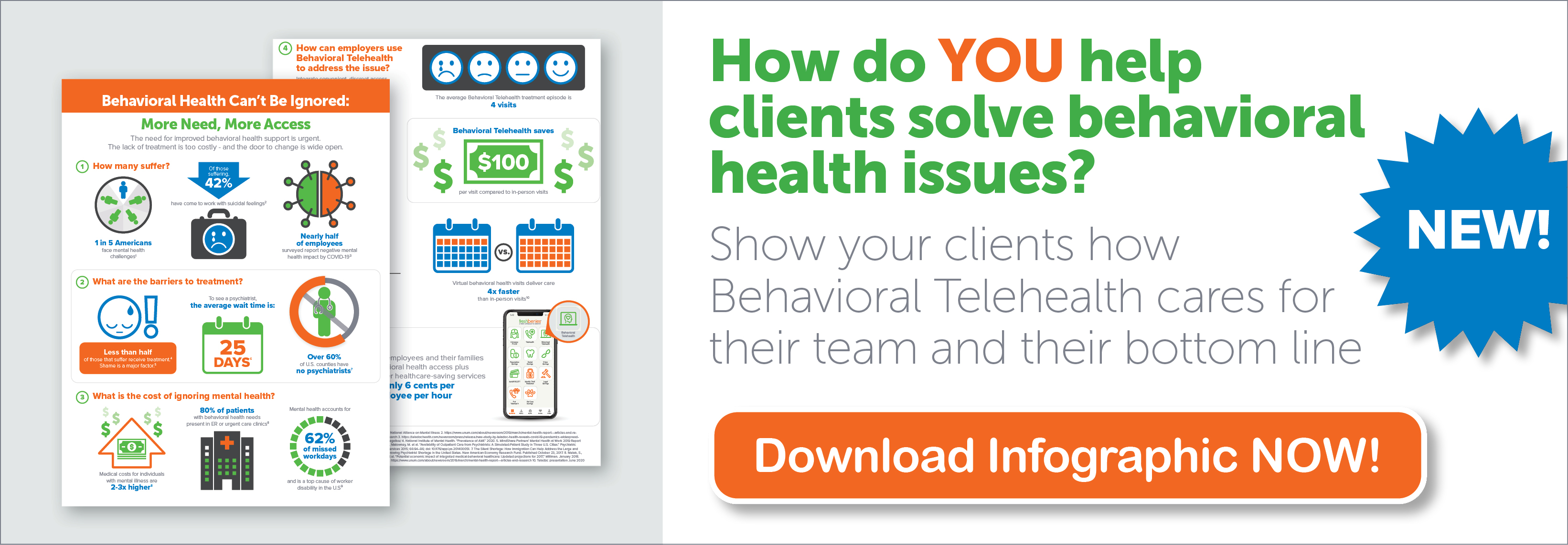3 Reasons Behavioral Health is a Benefits MUST
Have you seen numbers reflecting the tremendous surge for behavioral health support since COVID-19?
This new study reports nearly half (47%) of all U.S. respondents report negative mental health impact as one of the many ramifications brought on by the pandemic. The percentage jumps to 61% among laid-off or furloughed workers.
Today, I’m sharing 3 reasons a behavioral health benefit is vital both for employers and their employees.
1. The need is tremendous
Even before Coronavirus, the urgency for improved mental health support was astounding. The National Institute of Mental Health reported twice as many suicides as homicides in 2017. In 2018, 1 in 5 adults experienced mental illness - this represents 47.6 million people.
Fast forward to the past six months and surveys reveal a spike from 40% to 79% of employees who want remote forms of behavioral care. The need is growing and cannot be ignored.
2. The lack of treatment is too costly
The impact of mental health is far-reaching for every individual it affects, including detrimental effects to familial wellness. As if that alone was not too costly, negative ramifications are also seen in workplace productivity and increased healthcare costs. Consider these stats…
- 62% of missed workdays are attributable to mental health conditions
- Mental illness is one of the top causes of worker disability in the U.S
- The top 20% most-stressed employees cost $1500 more in healthcare
In light of accelerated needs for mental health support from the pandemic, how might these stats surge over the next year if we fail to improve access to behavioral healthcare?

3. The door is wide open
There is a growing acceptance for virtual care of behavioral health, and encouraging results that show improvement after only 2 virtual visits among patients with depression (69%) and anxiety (72%).
In this recent article published by BenefitsPRO, several pillars of behavioral health were identified, including…
a. Access and quality of care Availability of mental health benefits has improved, and more work is needed. Data-driven approaches to developing or expanding behavioral telehealth provider networks based on national clinical guidelines are essential to optimize care. Moreover, the use of innovative vendors and digital approaches can augment the traditional in-person service delivery models.
b. Integration and navigation With many programs available via mobile apps or digitally, employees need to understand behavioral health benefits are at their fingertips and can even be accessed privately. Virtual and telehealth behavioral solutions enable employees to have discussions from the comfort of their own homes rather than meeting face to face with a professional.
c. De-stigmatization and awareness Mental illness still carries a negative stigma in the workplace. Talking openly about mental health and illness and demonstrating genuine support from senior leadership are key components in shifting the narrative. Another important part of raising awareness is making time throughout the year to share information and explain the different behavioral health programs that are being offered.
The COVID-19 pandemic has vastly expanded the need for behavioral health resources. It has also created the opportunity for many people to get new exposure to telehealth. Taken together, increasing behavioral telehealth is one potential positive byproduct of this terrible pandemic.
Now it’s your turn. How are you addressing behavioral health with your groups? Comment below or email me at reid@freshbenies.com. Plus, reach out to discuss how freshbenies can help. All of our newest packages with telehealth include behavioral telehealth - and existing groups can add this service for an affordable PEPM.















